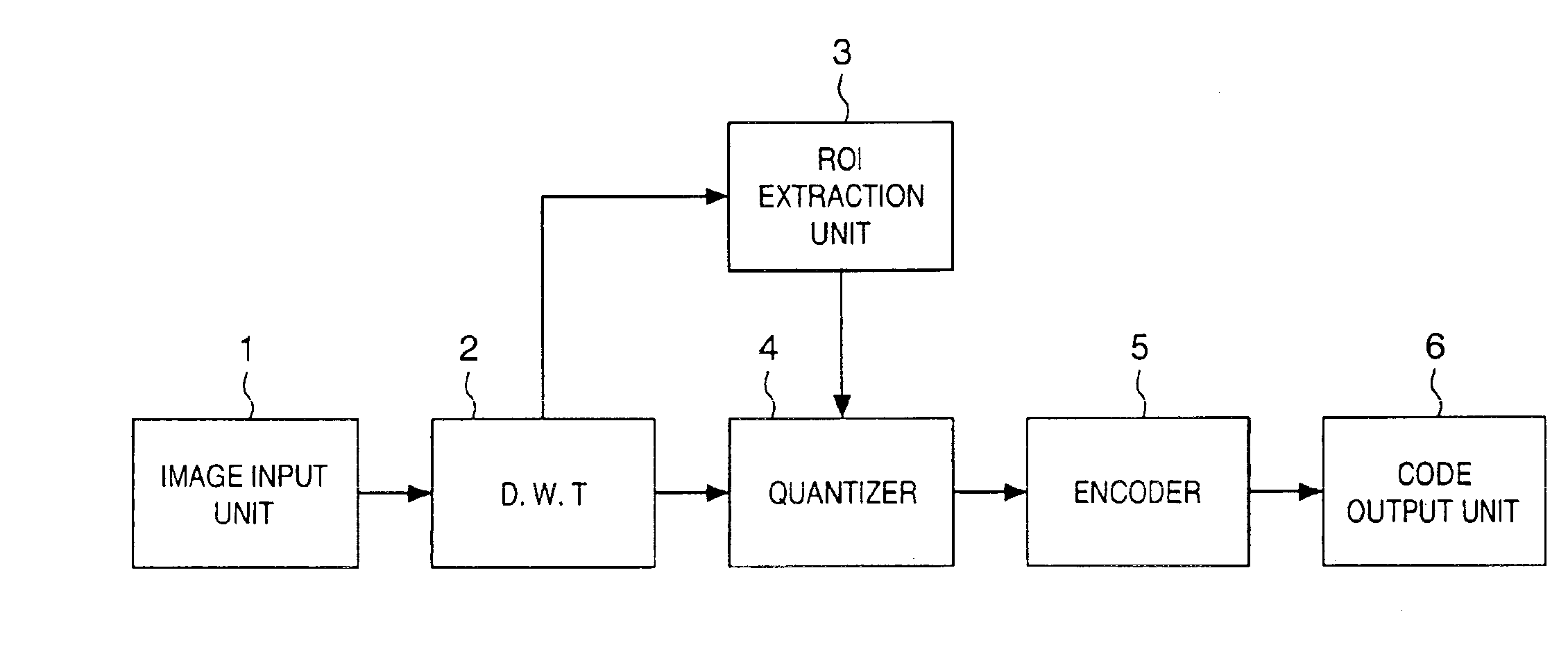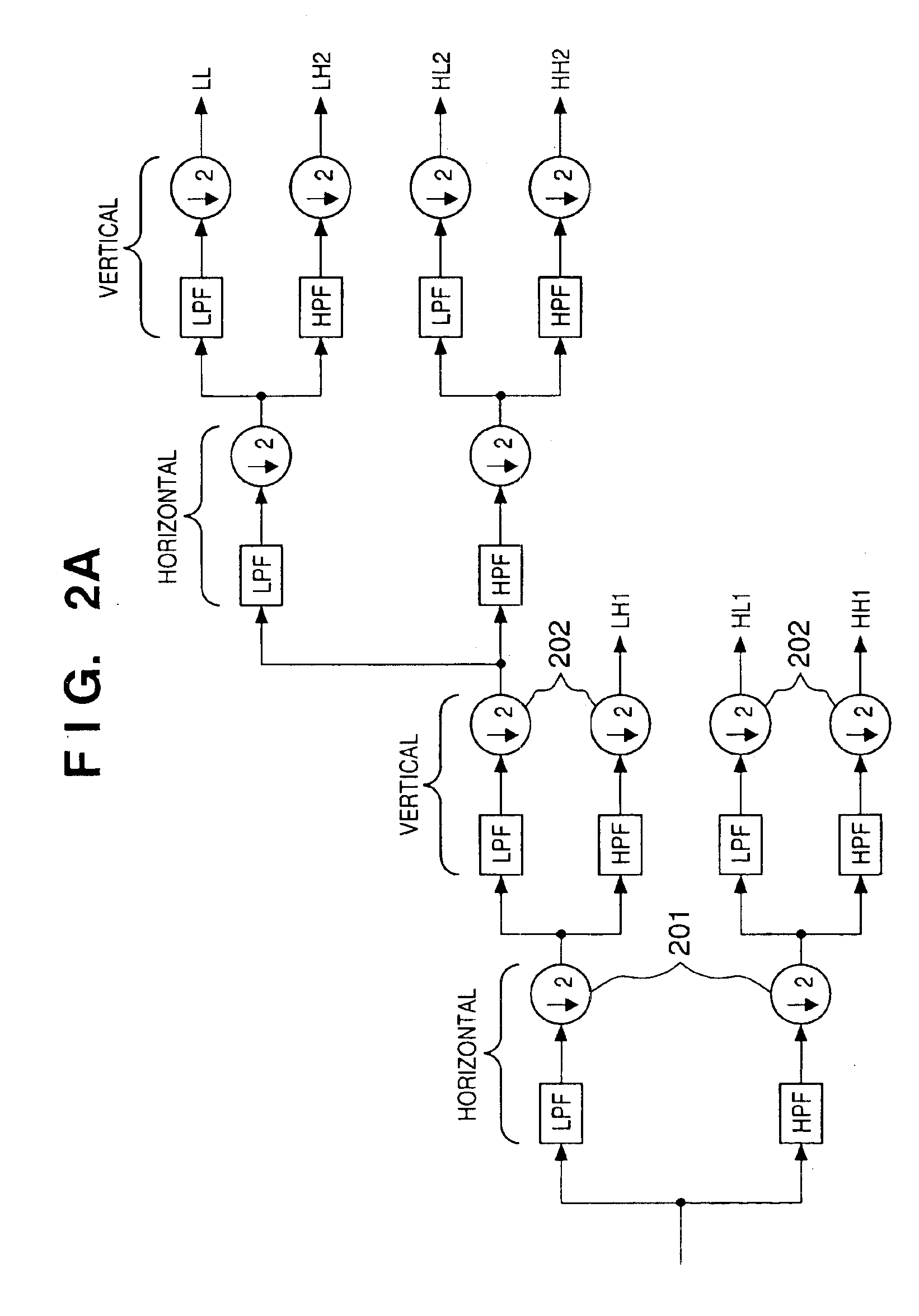Image encoding method and apparatus
- Summary
- Abstract
- Description
- Claims
- Application Information
AI Technical Summary
Benefits of technology
Problems solved by technology
Method used
Image
Examples
first embodiment
[0030][First Embodiment]
[0031]FIG. 1 is a block diagram illustrating the construction of an image encoding apparatus according to a first embodiment of the present invention.
[0032]As shown in FIG. 1, the apparatus includes an image input unit 1 for inputting image data. By way of example, the image input unit 1 is equipped with a scanner for reading a document image, with an imaging device such as a digital camera, or with an interface for interfacing a communication line. The input image is applied to a discrete wavelet transformation unit 2, which applies a two-dimensional discrete wavelet transform to the input image. An ROI (Region of Interest) extraction unit 3 extracts an ROI from the image that has entered from the image input unit 1. A quantizer 4 quantizes coefficients obtained by the two-dimensional discrete wavelet transform. An encoder 5 encodes the image signal that has been quantized by the quantizer 4, and a code output unit 6 outputs the code obtained by the encoder ...
second embodiment
[0066][Second Embodiment]
[0067]In the first embodiment described above, motion vectors within an image are detected minutely using subband signals obtained by application of the Haar wavelet transform, and an ROI is extracted based upon the distribution of these motion vectors. In the second embodiment, an ROI having left-right symmetry is extracted within an image having substantial left-right symmetry, such as an image of the human face, using subband signals obtained by application of the Haar wavelet transform in a manner similar to that of the first embodiment.
[0068]FIG. 7 is a block diagram illustrating the construction of the ROI extraction unit 3 according to the second embodiment for extracting an ROI having left-right symmetry. The ROI extraction unit 3 includes an arithmetic unit 40 for calculating degree of left-right symmetry and a region segmentation unit 41.
[0069]As shown in FIG. 7, in subbands obtained from the preceding two-dimensional discrete wavelet transformatio...
third embodiment
[0086][Third Embodiment]
[0087]In the first embodiment described above, motion vectors within an image are detected minutely utilizing subband signals obtained by application of the Haar wavelet transform, and an ROI is extracted based upon the distribution of these motion vectors. In the second embodiment, an ROI having left-right symmetry is extracted in similar fashion using subband signals obtained by application of the Haar wavelet transform. Next, in the third embodiment, segmentation of an input image into regions is carried out utilizing subband signals obtained by application of a wavelet transform and a region of interest in the input image is extracted.
[0088]An image having a low resolution often is used to perform region segmentation efficiently. The reason for this is that a region within an image contains more global image information, unlike edge information, for example. Accordingly, first the input image is subjected to region segmentation coarsely using the subband ...
PUM
 Login to View More
Login to View More Abstract
Description
Claims
Application Information
 Login to View More
Login to View More - R&D
- Intellectual Property
- Life Sciences
- Materials
- Tech Scout
- Unparalleled Data Quality
- Higher Quality Content
- 60% Fewer Hallucinations
Browse by: Latest US Patents, China's latest patents, Technical Efficacy Thesaurus, Application Domain, Technology Topic, Popular Technical Reports.
© 2025 PatSnap. All rights reserved.Legal|Privacy policy|Modern Slavery Act Transparency Statement|Sitemap|About US| Contact US: help@patsnap.com



